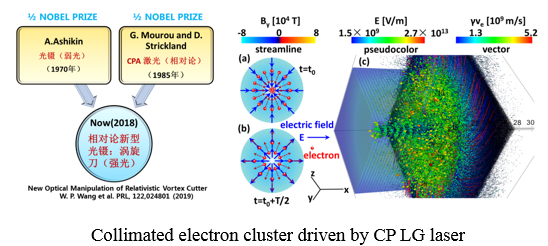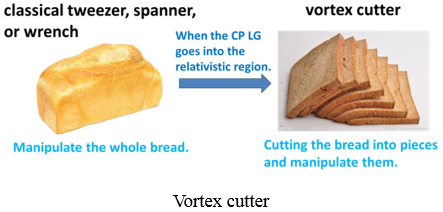A. Ashikin, G. Mourou, and D. Strickland shared the 2018 Nobel Prize in Physics for groundbreaking inventions in the field of laser physics. Of the three, A. Ashikin was awarded for the optical tweezers and their application to biological systems. Since 1970 when he firstly realized the micrometer-scale particle acceleration and trapping by the radiation pressure from the continuous laser, the optical tweezers have been widely used for plucking, pushing and pulling atoms and molecules without damaging them. With the invention of the chirped pulse amplification (CPA) technology by G. Mourou and D. Strickland, the intensity of the femtosecond laser goes into the relativistic region (>1018W/cm2), by which the matter can be instantaneously ionized into plasmas (including ions and electrons).
Recently, researchers at Shanghai Institute of Optics and Fine Mechanics, Chinese Academy of Sciences subvert the classical optical tweezers (Ashikin’s main contribution) into the relativistic-fs interaction region (Mourou and Strickland’s main contribution).
Researchers report a new relativistic vortex cutter driven by the Laguerre–Gaussian (LG) mode, which was carried out for the first time in three-dimensional particle-in-cell simulations. Studies show that the electric fields periodically concentrate and emanate within every laser wavelength for the reflected CPLP lp(p = 0, l = 1, σz = -1) laser, which just works like a vortex cutter, resulting in a relativistic ultra-short collimated electron cluster with a constant period in space. A single particle model is given and verifies that the cluster formation has a close relation with the parameters of orbital angular momentum (l) and spin angular momentum (σz).

To be clear, researchers compare the manipulated matter to “bread”. Previously, the weak classical tweezers, spanner, or wrench deal with the “bread” as a whole, while the relativistic vortex cutter proposed in this letter cuts the “bread” into pieces and manipulates them. The periodically concentrating and emanating electric fields in the vortex cutter working like an undulator can be used to generate radiation sources, such as x ray.
The parameters of the clusters, such as energy and duration in space, can be freely controlled by the laser intensity and wavelength, which makes it possible to be used as a controllable particle injector for the laser wakefield accelerator (LWFA), THz radiation sauce and Betatron radiation source.
In addition, it should be noted that the electron clusters are highly collimated by the LG laser, which provides potential high-flux sources for the ultrafast electron diffraction, fast ignition, and ultrafast electron diagnostics.
This research, entitled "New Optical Manipulation of Relativistic Vortex Cutter" has been published in Physical Review Letters.
This work was supported by the National Natural Science Foundation of China, Strategic Priority Research Program of the Chinese Academy of Sciences, and the Ministry of Science and Technology of the People’s Republic of China.

Article website:
https://journals.aps.org/prl/abstract/10.1103/PhysRevLett.122.024801
Contact:
Mr. Cao Yong
General Administrative Office
Shanghai Institute of Optics and Fine Mechanics, CAS
Email: caoyong@siom.ac.cn